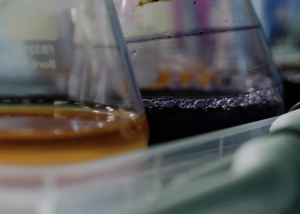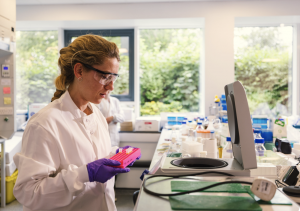These two friends have found a better solution that taps into the genetic makeup of fashion.
In a laboratory in Norwich, UK, the Colorifix team is engineering microorganisms to produce natural dyes. Under the watchful gaze of a team of synthetic biologists, petri dishes come alive with a menagerie of vivid organisms in new shades of crimson, violet and cerulean. These experimental colours could one day adorn the clothes you wear if they pass the teams exacting requirements.
By replicating the DNA sequences that allows these organisms to produce pigments, the company is aiming to replace synthetic dyes. The process was developed by co-founders of Colorifix, Orr Yarkoni and Jim Ajioka. The pair were driven to develop a way to replace synthetic dyes after a trip to Nepal, where they were conducting research on arsenic poisoning. In Kathmandu they became aware of the toxic impact of the textile dyeing industry. “The chemicals they dump in the water are irretrievable,” says Ajioka.
The textile dyeing industry has profound environmental and social impacts. And it’s not just to do with the chemicals which can be released into the environment. The material production stage, which includes textile formation, scouring and coloration, accounts for 53% of the fashion industry’s total emissions.
Dyeing is an extremely energy intensive process, requiring the heating of large amounts of water to loosen fabric fibres so that they will accept the dyes.
The textile industry uses around five trillion litres of water annually for dyeing. Many dyehouses in South Asia and elsewhere dump the waste water, which can contain formaldehyde, lead and chromium, straight into rivers and waterways. This can adversely affect aquatic life in many ways, including preventing photosynthesis by blocking sunlight. The chemicals can also affect people who depend on the water as a drinking source, as well as farming communities, since the toxins can lower soil productivity by blocking soil pores.

A biological dyeing process inspired by nature.
Colorifix’s technology can help reduce some of the industry’s footprint. The process begins with the identification of natural pigments, which can come from sources such as animals and plants. The genes that create these colours in nature are duplicated with lab-grown microorganisms. This procedure only needs to be completed once, after which the DNA data is saved in a database. Ajioka, Colorifix’s chief scientific officer, explains the resulting product is a natural dye, adding, “we use a genetically modified (GM) process to make a nonGM product”.
The microorganisms are then delivered to dye-houses, where they are fermented in Colorifix’s custom fermentors. “It takes between 12 and 20 hours to produce a batch of natural dye, with the size of your fermentor defining batch size” says Ajioka. When dyehouses need to produce another colour, the same fermentor can be used for the process. Colorifix has engineered hundreds of colours, with 14 currently available to use on customer sites. Yet, Yarkoni believes “all synthetic colours must be replaced, if we’re to truly disrupt the dyeing industry.”
Designing a system that can be integrated into the existing process was key for the cofounders. “We needed a solution that could be integrated into the current process. If implementing costs are too high, the technology won’t be scalable,” says Yarkoni. Aside from onboarding the fermentor, which costs less than a dye machine, no other specialist equipment is necessary. “Our methodology also won’t lead to job displacement since it’s integrated into the current dyeing process,” Ajioka adds, highlighting both the financial and social benefits of their product.
Minimising environmental impact
The microorganisms in Colorifix dyes are killed by the heat during the process, removing a key polluting factor in conventional dyeing, when waste water is poured into water bodies.
“Cells naturally produce nutrients and concentrate other things such as salts, that act as ‘natural fixers’ during dyeing,” says Ajioka. “This means no chemicals need to be added to ‘fix’ the colours onto fabric. In conventional dye-houses, chromium fixatives are sometimes added, rendering some garments non-recyclable, says Ajioka.
Colorifix can reduce water use by 77% overall compared to traditional dyeing processes, though exact levels may differ depending on what is being dyed. The company also uses less energy, natural gas and chemicals during the dyeing process, versus the conventional dyeing procedure.
However, the overall water reduction of Colorifix technology can be higher or lower, since global dyeing processes differ. Likewise, other climate benefits vary by region. For example, in most European countries, natural gas is used to provide the energy to heat dye-house boilers, while many South American countries use biomass. Operational emissions also differ by country, due to the varying transportation systems, making comparisons harder, adds Ajioka.

What’s next for Colorifix?
The co-founders say they’re in different phases of onboarding with Brazil, Turkey and Sri Lanka, and their next focus is Asia, where a lot of textile dyeing for the world’s biggest brands occurs. Despite this, there are several factors that curb Colorifix’s ability to scale quickly, including the lengthy research, development and quality control process, and meeting regulatory criteria.
Aside from meeting textile dyeing standards, Colorifix partners also need licences to work with a GM process. “Since GM rules vary by country, we often need to speak to different people,” says Yarkoni.
So far, Colorifix has met with success while bringing their technology to countries including Italy and Portugal. The textile industry may have already stained their sustainability records, but companies like Colorifix may change the tide for the industry. Colour by colour, the company is demonstrating there are more environmental, cost-effective ways to dye fabrics, in a way that is less harmful to the health of the planet.
This article contains sponsored content part of the Fashion Redressed Series.